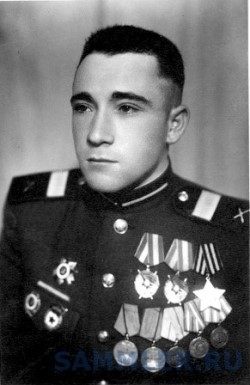Abram Mordukhovich was born in 1922 in Smela, 170 kilometers southeast of Kiev. In 1933, he and his family moved to Birobidzhan. Having graduated from school in 1939, he entered the Faculty of Shipbuilding of the Vladivostok Polytechnic Institute (now known as the Far Eastern State Technical University). In 1940, having just begun his second year of study, he was drafted into the Red Army.
With the beginning of the Soviet-German war, Mordukhovich was sent to the Southwestern Front. In 1941, he fought in Western Ukraine (the former southeastern Poland) and southern Ukraine, and took part in the battles for Rostov-on-Don (southern Russia). In May 1942, he was seriously wounded. With the enemy advancing, his hospital was evacuated from Chernianka, 100 miles west of Voronezh. During the evacuation, the recuperating Abram Mordukhovich narrowly escaped death in a German air raid. In the winter of 1942-43, he took part in the defense of Stalingrad, and then fought in the Red Army counter-offensive from the city. In the summer of 1943, he participated in the Kursk Salient operation. During the crossing of the Dnieper River in the fall of 1943, he destroyed five enemy tanks. In 1944, he fought in Western Ukraine and Poland. In August 1944, during the Lvov-Sandomierz Offensive, Mordukhovich, serving as the commander of an anti-tank gun of the 232 Guards Artillery Regiment, was the first to destroy a new model of the German "Tiger-II" tank. In winter 1945, he took part in the crossing of the Oder River (After the war, he would regard this operation as the hardest one in his wartime career1 ). Mordukhovich ended the war in Prague, where, as late as May 9th, 1945 and the subsequent days, he was busy suppressing the last centers of German resistance (mostly Waffen-SS units).
Despite serving in the anti-tank artillery throughout the war, Mordukhovich took part in hand-to-hand combat on several occasions. He was wounded twice. He finished the war in the rank of senior sergeant.
In January 1945, Abram Mordukhovich was nominated for the title of Hero of the Soviet Union. The nomination was rejected, despite being signed by Colonel General Zhadov, commander of the 5th Guards Army, and Mordukhovich was awarded his second Order of the Red Banner instead. In addition to two Orders of the Red Banner, he also received the Order of Glory, 3rd class (in 1944), the Order of the Patriotic War, 2nd class (in the same year), and several medals.
After the war, Abram Mordukhovich graduated from the Khabarovsk Pedagogical Institute (the Faculty for History) and the Journalism Department of the Khabarovsk Supreme Party School. He was a member of the editorial board of the newspaper Birobidshaner Shtern (the leading press organ of the Jewish Autonomous Region in the Russian Far East), writing for both its Yiddish-language and Russian-language editions.
In the late 1990s, Abram Mordukhovich and his family settled in Israel. He died in 2013.2
From Vladislav Tsap's essay on Abram Mordukhovich: Sergeant Mordukhovich destroying the Tiger-II tank
"Concerning this tank, Abram Iliich told me:
'Among the tanks, some big and unfamiliar vehicle is crawling. We are pounding this tank ceaselessly, but it shrugs off everything we throw at it. The shells cannot dent it. The tank hit some obstacle, began to bypass it, and exposed its side to us. At this moment, I hit it with a shell. The tank caught fire. After the battle, the top brass descended upon me, and I realized that I’d knocked out a new 'Tiger'. The commander nominated me for Hero [of the Soviet Union], but the higher-ups rejected me, and I received only an order. And the tank was ascribed to somebody else'.
Most likely, he knocked out the first "Tiger II" (also known as the "Royal Tiger"). This happened on the Sandomierz bridgehead; it was there that the Hitlerites deployed these new seventy-ton machines against our troops."







